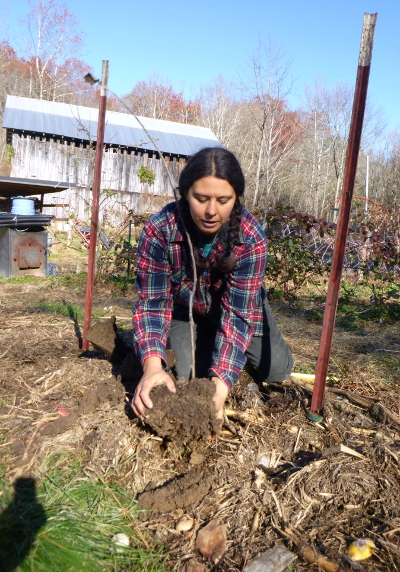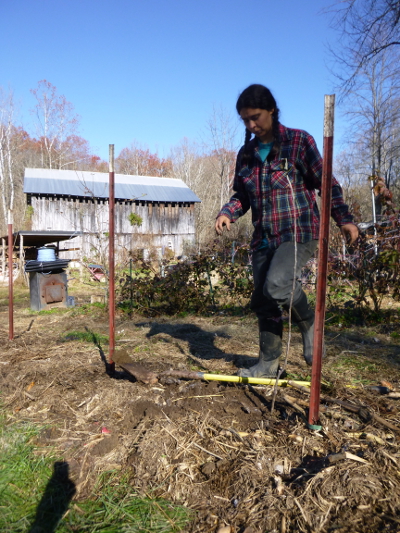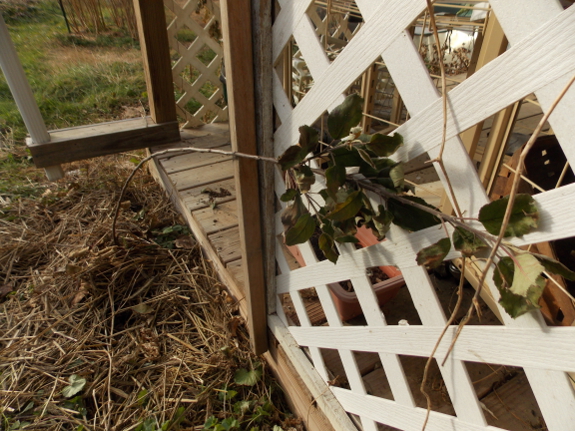
Three new high-density apple experiments
 Although it's a little premature to count our two-year-old high-density apple experiment
as a success (since frost nipped all of the blooms this spring), I'm
feeling very positive about the system. Planting the apple trees close
together allows me to try out lots of different varieties, which in turn
makes it easy to select varieties that resist cedar apple rust and our other local bugaboos. The high-density row doesn't take up much precious garden space, and the summer pruning (although frequent) is simple and fun. No wonder Mark and I chose to plant two more high-density apple rows this fall!
Although it's a little premature to count our two-year-old high-density apple experiment
as a success (since frost nipped all of the blooms this spring), I'm
feeling very positive about the system. Planting the apple trees close
together allows me to try out lots of different varieties, which in turn
makes it easy to select varieties that resist cedar apple rust and our other local bugaboos. The high-density row doesn't take up much precious garden space, and the summer pruning (although frequent) is simple and fun. No wonder Mark and I chose to plant two more high-density apple rows this fall!
With this second
planting, I'm experimenting in three different directions. Two years
ago, I mostly chose trees grafted onto Bud 9, M26, and Geneva 11
rootstock, meaning that the trees are true dwarfs, but I also included
two trees on a semi-dwarf (MM111)
rootstock. The semidwarf trees grew very well...but they've already gotten
quite a bit bigger than their neighbors. So, when I grafted  onto
MM111
for some of this year's new trees, I expanded the within-row spacing to 6
feet, hoping that the additional elbow room will help our semidwarf
apples
achieve their full potential while still toeing the high-density line. I
also plan to train the MM111 trees' limbs down considerably below the
horizontal this time around, which I was a bit more cautious about in
previous years but which I've since decided is definitely a good option
for
high-density apples in the backyard.
onto
MM111
for some of this year's new trees, I expanded the within-row spacing to 6
feet, hoping that the additional elbow room will help our semidwarf
apples
achieve their full potential while still toeing the high-density line. I
also plan to train the MM111 trees' limbs down considerably below the
horizontal this time around, which I was a bit more cautious about in
previous years but which I've since decided is definitely a good option
for
high-density apples in the backyard.
I also opted to branch
out and try yet another rootstock this year --- M7, which will produce
trees midway in size between the true dwarfs on Bud 9 and the semidwarfs
on MM111. My M7 trees went into the ground at 53-inch spacing but will
otherwise be treated the same as the MM111 trees. I'll be curious
to see, over the next few years, which rootstock turns out to be the best
fit for high-density plantings on our farm. It's a bit of a tradeoff ---
the more dwarfing the rootstock, the more precocious the tree, meaning
that we'll get more fruits faster. But, at the same time, truly dwarf
rootstocks have a hard time growing if you don't give them constant TLC,
and a few of the trees in my original planting (on Geneva-11 or Bud 9
rootstock) did fail to thrive.
Hopefully, either the M7 or MM111 trees (or both) will provide a happy
middle ground --- apple trees that do pretty well without watering and
other bonus attention, but that also produce within a few years after
planting.

I've read lots of good and bad about espaliers (my third high-density apple experiment), so I earmarked only one tree for this final endeavor.
I settled on an informal design set against the south side of our front
porch and began by bending the young tree so the top was nearly
horizontal. As watersprouts inevitably pop up from the flattened trunk,
I'll probably bend them at a 45-degree angle to create a type of lattice
pattern...or whatever seems to make sense from the growth pattern of the
tree. Since I'm far from confident that my espalier will thrive,
though, I chose our Chestnut Crab for the experiment ---after all, I'm
mostly growing this sweet crabapple variety out of sentimental attachment to a similar
tree of my youth, so I won't feel too bad if I don't get high yields.
I'll keep you posted on
all three new plantings in the years ahead...and hopefully will be able
to report in summer 2015 about our first big crop from our older
high-density planting. In the meantime, stay tuned for another post
about next year's high-density experiment, which will veer off in yet
another direction.
Want more in-depth information? Browse through our books.
Or explore more posts by date or by subject.
About us: Anna Hess and Mark Hamilton spent over a decade living self-sufficiently in the mountains of Virginia before moving north to start over from scratch in the foothills of Ohio. They've experimented with permaculture, no-till gardening, trailersteading, home-based microbusinesses and much more, writing about their adventures in both blogs and books.
Want to be notified when new comments are posted on this page? Click on the RSS button after you add a comment to subscribe to the comment feed, or simply check the box beside "email replies to me" while writing your comment.

Michealann --- The MM111 trees I put in the high-density area (meaning I'm pruning and training them quite small) I went ahead and staked because their neighbors were staked and it would have looked odd to leave them out. I don't think they really needed the stakes though.
Training the branches below horizontal has been working out well on some older high-density apples. I was a bit tentative about it at first and let some be horizontal to a bit above horizontal, and if anything, I wish I'd gone lower with everyone. I haven't seen a lot of water sprouts (the one problem you might have), although the more vigorous trees on MM111 are tougher to keep in line than the true dwarfs.